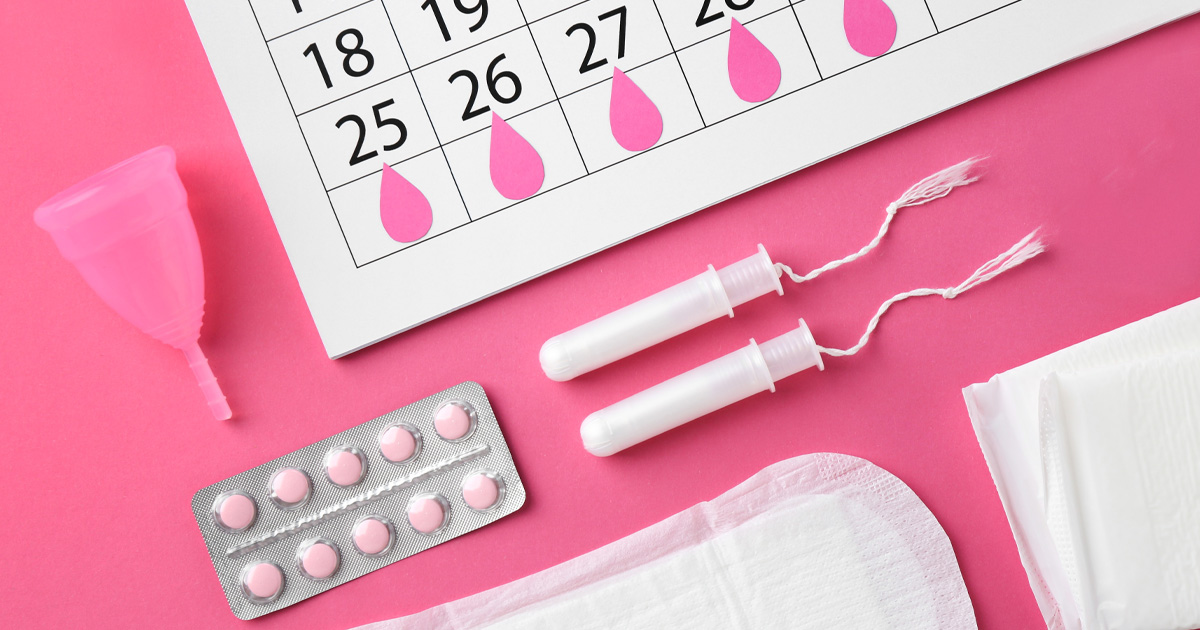
Gynecology, Self-care
A New Era in Menstruation: New Products Revolutionizing Period Care
Since the dawn of time, women have found creative ways to manage their periods. Before the 1800s, women used things like rolled-up grass, leaves, and sea sponges. Fortunately, we’ve come a long way since then. Fast forward to today where innovations in technology have brought us out of the dark ages and into a new era of menstruation. Today’s products are designed to help women lead our fullest lives, with less worrying about leaks. From period underwear to menstrual cups and period tracking apps, we’re exploring some of the latest developments in period products and factors to consider when choosing the right option for you.
Period underwear

In many ways, period underwear looks and feels like normal underwear, with a plethora of styles (i.e., hip-hugger, brief, booty shorts) and colors available. But take a closer look and you’ll see that this underwear is formulated quite differently. Built with extra layers of fabric for higher absorbency and made with special moisture-wicking and antimicrobial fibers, this underwear works well to keep you dry and keep any odor at bay.
Depending on the brand or style, period underwear can hold a considerable amount of fluid ranging from the equivalent of between 2 to 5 tampons.
As a bonus, most are machine washable, and reusable making them both a cost-effective and eco-friendly choice. When you consider that about 12 billion pads and 7 billion tampons end up in landfills each year, this could make a significant impact on our environment.
If you have heavier periods, period underwear can help you feel more confident by providing back-up leak protection. Because you don’t have to insert anything into your vagina, period underwear can also be a great option if you experience vaginal discomfort or dryness from other period products. Overall, period underwear is great at achieving maximum comfort while keeping you dry and clean!
Menstrual cups

Unlike other period products that absorb fluids, menstrual cups work by storing fluids. Menstrual cups are inserted into the vagina so that they sit up against your cervix. They come in a small funnel-like shape and are made of silicone or latex. Most brands carry two sizes, small and large, that are based on your flow, age, and position of your cervix. They also come in many different colors and styles.
Menstrual cups can typically hold about an ounce of liquid, about three times the amount of tampons. Once inserted, they can be left in up to 12 hours, saving you the hassle of frequently changing a tampon or pad.
Like period underwear, they are both washable and reusable. Cleaning and storing your cup properly are essential to maintaining good hygiene. Before insertion and after each use, you should wash both your hands and the cup with a mild, unscented soap. At the end of your cycle, you’ll want to boil it with clean water to fully remove all bacteria. Most brands provide you with a storage bag that you can keep in a cool, dry place until your next use.
For busy women who are on-the-go, the fact that menstrual cups can last up to 12 hours can be a major plus. Insertion and removal of a menstrual cup can be bit messy at first, but once you get the hang of it you could save yourself many trips to the restroom.
Menstrual discs

Menstrual discs are very similar to menstrual cups in that they are worn inside the vagina and work by storing fluids. However, unlike a menstrual cup, which uses suction to stay in place, a disc is held by gravity. The shape, as it sounds, is a round, low-profile disc that looks similar to a diaphragm.
The biggest difference according to most users, is the insertion and removal. Menstrual cups tend to be easier to insert and remove than menstrual discs which can take some time to get used to.
If you’ve never tried an internal menstrual product before, you may opt to try a menstrual cup first. However, if you’re very familiar and comfortable with navigating your internal anatomy, a disc may work just fine.
While menstrual cups and discs have many of the same benefits, some women prefer discs because they can be worn during penetrative sex.
New formulations of tampons

You may have noticed some new advertising on tampons as you stroll down the pharmacy aisle. Many brands today are now offering organic tampons that are free of dyes, fragrances, and chlorine bleaching. Organic tampons are typically made from 100% cotton compared to a traditional tampon that is made of a mix of rayon and chlorine bleached cotton.
While experts agree there’s no real health benefit to using an organic tampon, assuring that traditional tampons are perfectly safe.
One note here: if you are someone who experiences frequent yeast infections or bacterial vaginosis, a fragrance-free tampon can be helpful avoiding any pH disruption caused by tampons.
Period tracking apps and jewelry
 Gone are the days of struggling to predict when your next period would come. There are now dozens of apps and even wearable jewelry like watches that can help you track your cycle, give you reminders when to take your birth control, and track patterns in sleep and stress. Leaning into your menstrual patterns can tell you so much about your body!
Gone are the days of struggling to predict when your next period would come. There are now dozens of apps and even wearable jewelry like watches that can help you track your cycle, give you reminders when to take your birth control, and track patterns in sleep and stress. Leaning into your menstrual patterns can tell you so much about your body!
How do I choose the right period product?
With so many options on the market, it can be overwhelming to decide which one to choose. Some factors to consider are cost, sustainability, comfortability, and what fits in best with your lifestyle. Fortunately, if something doesn’t work, there are so many other products to choose from!
From combatting period stigma to developing game-changing products that fit our individual needs — it’s exciting to see the progress we’ve made in period care! And remember, if you have any concerns regarding your menstrual cycle such as heavy bleeding or irregularity, your Axia Women’s Health provider can help. Let’s join together in this period revolution!


































































